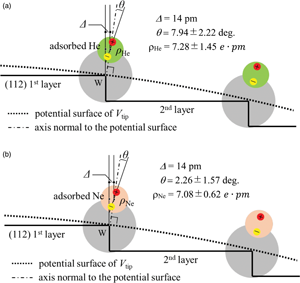No CrossRef data available.
Article contents
Comparative Studies on Local Barrier Field Variations Above Field-Adsorbed Helium and Neon with a Micro-Probe Hole Field Ion Microscope
Published online by Cambridge University Press: 05 September 2022
Abstract

The local field ion emission properties of helium and neon around a step edge atom of W(112) were examined at liquid nitrogen temperature using a micro-probe hole field ion microscope combined with a pulse-counting analysis. We have analyzed the mapped field ion densities obtained for both imaging gas atoms at their respective best local image voltages based on the formula for tunneling barrier strength and have evaluated the dipole moment of polarized adatom as well as the local field enhancement factor at the adatom site. We found that the dipole moments of helium and neon adatoms showed the same value, although the best local image field acting on the helium adatom is much higher than that on the neon adatom. We also found the same magnitude of local field enhancement factors for both noble gas field adsorptions. These results imply that the key to the best local image condition is the tunneling barrier field variations above the adatom. The vital role of the imaging gas atoms is to form an optimum dipole moment to create an ideal electric field distribution for the best local image appearance at each atom site depending on the different chemical nature of adatom species.
Keywords
- Type
- Materials Science Applications
- Information
- Copyright
- Copyright © The Author(s), 2022. Published by Cambridge University Press on behalf of the Microscopy Society of America



